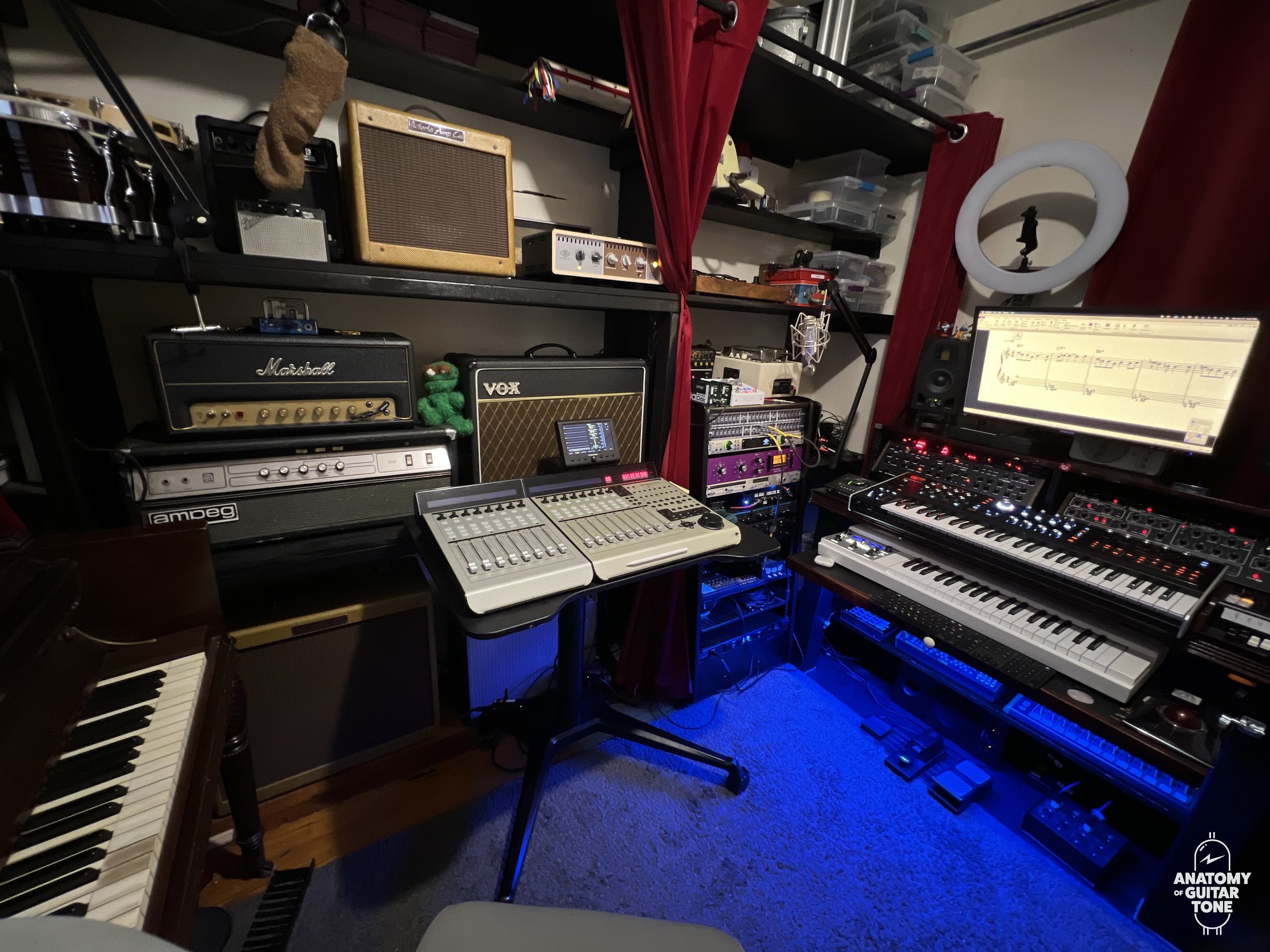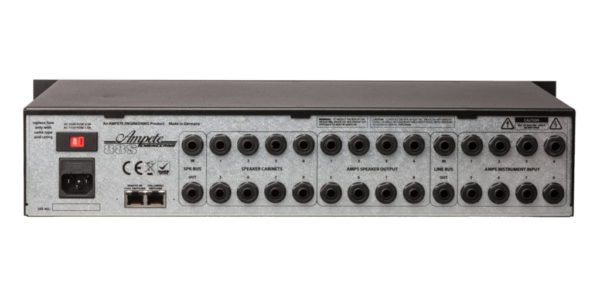Ampete 88S Studio 2 Amp Switching System
When recording multiple guitars on a composition, I often find using different amps on different tracks helpful. This is because guitars are very midrange-heavy instruments. The more guitars you layer on top of each other, the more muddy things can become.
Each part can lose its identity when you start layering the same sound on top of the same sound. So I often try different guitars and amps to help each guitar part stand out as a multi-guitar layered track.
I often see guitarists switch to another pedal on their pedalboard, but in my opinion, that doesn't change the sonic imprint enough, and stacked guitars can still lose their identity.
The best way to carve out some sonic space if stacked guitars are getting a little cluttered is to use a different guitar, amp, or both.
Of course, there are still limits to how many guitars you can overdub and have a great arrangement. So there are times when the answer lies in adding other instruments (textures) aside from multiple guitars for clarity in the arrangement.
But when you want multiple guitars and need each one to have an identity, switching guitars and amps is a significant plus.
I have a variety of guitars, amps, and pedals in my studio just for this purpose. For this reason, I prefer to cut guitars in my studio rather than others.
Guitars and pedals are pretty easy to swap out on sessions. However, swapping out guitar amps can be a little more labor-intensive. Amps can be heavy, and most people don't have all their amps set up in a room ready to be miked.
On the Clock
A lot of projects I work on these days have time restrictions. So I want the benefit of using different amps but not the setup time. I still use real amps. I find them easier to mix and prefer the touch sensitivity. It's quicker for me to get a sound with a real amp than a modeler or amp sim, which I end up constantly tweaking and being unsatisfied with.
Stacks
I built shelves (with the help of a friend) in my studio to place all my amps for easy access. But having them on shelves wasn't enough to streamline the process.
Along with trying various amps, it's also a lot of fun to try amps with different speakers. For example, I like the sound of the Headstrong Lil King into my Vox AC15 cab.
Reaching behind amps and playing with speaker cables is messy and counterproductive. So instead, I needed to find a tool that would allow me to select different amps and speakers.
Solutions
Luckily Ampete makes the 88S Studio 2 amp switcher, and it's perfect for the job. The 88S gives me all the tools to use multiple amps on sessions and to work quickly.
With the Ampete 88S, I can select various amps and speakers, but I can also send the signal to my UA OX for silent recording. I still prefer to mic amps, but living in an apartment in Brooklyn, NYC, limits the hours I can record amps. So the Ampete 88S is like a patch bay for my amps.
I was initially concerned about ground loops and noise when connecting multiple amps, but the 88S is entirely silent—what a relief. It's a well-designed utility tool.
Spotlight
There are a lot of gear guitarists buy that tend to get more attention, but few pieces are more helpful in a studio setting.
I use more amps than ever, which means I'm happier with the guitar tones I'm tracking. In addition, I can audition amps quickly before I choose the right amp.
My setup consists of 7 amps. I run a Headstrong Lil King, Victoria 35115, Victoria 518, Marshall SV20, Ampeg V48, Zvex Nano, and a Vox AC15.
Each of these amps runs into the Ampete 88S, which allows me to route amps to various speakers. You do have to make sure the amps and speakers match ohms. The 88S is an amp switcher but not an ohms matcher.
There is an excellent discussion in the Ampete 88S manual about ohms which is worth a read.
Color Wheel
Let's listen to some examples of using different amp and cab pairings. I'm playing a vintage 1964 Guild Starfire III into an Analog Man ARDX20.
EX1: Headstrong Lil King using the Headstrong cabinet with an Eminence Legend 12" speaker.
EX2: Headstrong Amp into a Vox AC15 cabinet with 12" Alnico Blue Speaker.
EX3: Vox AC15 amp into the Vox AC15 cabinet.
EX4: Vox AC15 Amp into the Headstrong Cabinet.
As you can hear, connecting amps to various cabs can give you a variety of colors from an amp.
Cabs miked with an AEA R84 A Ribbon mic into an API 312 Preamp into a Purple Audio MC77 into Luna.
Cheat Sheet
I used console tape to write down the ohms of every amp and placed it on the front of the 88S so I could match them correctly. Less to remember when in a hurry.
Features
The Ampete 88S allows you to simultaneously send an amp to up two cabinets.
The input for your guitar signal into the 88S has either buffered input through a front input jack or non-buffered through the back panel line bus input. Yet another way Ampete thought of flexibility.
“The 88S feels like it was designed by musicians with a lot of studio and stage experience.”
The buffer on the 88S is an excellent sounding buffer. But there are times when I still prefer to not use a buffer. Often in sessions, I check both input options to hear what sounds best for the sound. It's not a blanket decision.
A Note About Buffers
The word buffer has become a dirty word in some circles these days. Rather than having a blanket good vs. evil mentality, I prefer to listen to how every element colors my guitar tone.
What works best for one session or gig might not work for another. Therefore, I find it much better to know all of your gear and its tonal characteristics. Application is key.
“What works best for one session or gig might not work for another. ”
Sometimes you may need a buffer for technical reasons like running long cables or a long series of true bypass pedals in a row.
Sometimes you may like the sound as a buffer to color the tone. Some. Guitarists love the Boss CE-1 chorus as a preamp for its flavor.
So to make a statement that all buffers are evil is close-minded. I hear the color they add, and I can tell you there are a variety of colors. So not all buffers are equal.
There are times when plugging straight into the amp is the best option. Other times I may want to run through a buffered pedal or two.
The point is, what works for you and the situation may vary. So experiment and learn to troubleshoot your tone when you're not happy. Gain perspective of how each element makes an imprint on your sound.
EX1: Telecaster with Voodoo '52 pickups straight into a vox AC15 going into a UA OX into an API preamp, Purple Audio MC77 into Luna.
EX2: Telecaster with Voodoo '52 pickups using the buffered input of the Ampete 88S into a Vox AC15 going into a UA OX into an API preamp, Purple Audio MC77 into Luna.
EX3: SG Custom with Gemini Mercury One pickups straight into a Vox AC15 going into a UA OX into an API preamp, Purple Audio MC77 into Luna.
EX4: TSG Custom with Gemini Mercury One pickups using the buffered input of the Ampete 88S into a Vox AC15 going into a UA OX into an API preamp, Purple Audio MC77 into Luna.
Remote Locale
The Ampete 88S does allow the option to connect a remote switch (88R) for switching between amps and cabs. This is handy if your amps are far away. You could place the remote control on your desk and switch amps/cabs until your heart is content.
I'm not having that issue in my small studio. But hopefully, someday, that will be an upgrade I'll need to make.
Links
Ampete thought things through. The 88S also has an option to daisy chain multiple switchers together if you have more cabs/amps than one 88S will fit.
Alternatively, if you have just a few amps to select, Ampete offers a 4x4 amp/cab switcher.
There is a lot of flexibility with the 88S and Ampete amp switchers; there are even line-out options if you want to route your amps to outboard effects and power amps.
Musicians Mindset
The 88S feels like it was designed by musicians with a lot of studio and stage experience. As a result, it solves problems conveniently.
“Whatever it is, the way you tell your story online can make all the difference.”
Sometimes the best pieces of gear you own are the ones that you don't have to think about. The Ampete 88S works transparently for me every day. It was easy to hook up and made my life easy without further complications or issues.
I've often incorporated new pieces of gear into my studio that took some time to integrate or work the bugs out. So I was pretty impressed upon hooking up the 88S that it worked seamlessly without any noise or unexpected behavior.
As I mentioned earlier the fact that no extra noise was induced into my signal chain was very impressive. Every time I get a piece of gear, I'm nervous about noise. Power is dirtier than ever, and there is more RF interference in our modern world. It's been a bit of a puzzle containing noise living in an NYC apartment and using it as a professional studio. Unfortunately, I can't re-wire the whole place.
The Ampete 88S is nice and quiet, which was totally refreshing.
Speak to Me
Warning: aside from making sure the ohms match each speaker, you should also know the power handling of each speaker. You don't want to send a 100watt Plexi into a Princeton speaker at full volume.
Tip: It's also a good idea to add the wattage of speakers to the console tape on the front of the 88S. This way, your eyes will see you're about to send a dimed Plexi to a Princeton cab.













